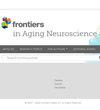研究自我保健方法对健康老年人大脑活动的影响
IF 4.1
2区 医学
Q2 GERIATRICS & GERONTOLOGY
引用次数: 0
摘要
引言有关大脑老化的研究通常发生在活跃的环境中,但对静息状态下大脑活动的研究却相对较少。然而,研究静息状态下的大脑活动可以深入了解不受特定任务影响的自发神经过程。研究目的方法77名61至87岁的老年人完成自我护理实践问卷、神经心理学测试和静息状态脑电图(EEG)记录。结果虽然神经心理学测试在D-SC组和T-SC组之间没有发现显著差异,但大脑活动模式却显示出不同的行为。T-SC 组的大脑活动模式更符合已建立的老龄化大脑模型,而 D-SC 组的大脑活动模式则与年轻成年人的大脑活动模式类似。具体来说,T-SC 组表现出与记忆和执行功能表现相关的过度激活,同时后部区域的阿尔法功率增高。结论 研究结果表明,自我保健实践与老年人大脑活动之间存在着微妙的关系。T-SC组的大脑活动模式与保守衰老一致,表明典型的衰老特征得以保留,而D-SC组的大脑活动则表明存在潜在的保护作用。这种效应可能与促进认知老化发展和恢复能力的自我保健策略有关。本文章由计算机程序翻译,如有差异,请以英文原文为准。
Examining the influence of self-care practices on brain activity in healthy older adults
IntroductionStudies on the aging brain often occur in active settings, but comparatively few investigate brain activity in resting states. However, exploring brain activity in a resting state offers valuable insights into spontaneous neural processes unaffected by task-specific influences. Objective: To investigate the relationship between self-care practices, cognitive function, and patterns of brain activity in healthy older adults, taking into account predictions from aging brain models.Methodology77 older adults aged 61 to 87 completing a self-care practices questionnaire, neuropsychological tests, and resting-state electroencephalogram (EEG) recordings. Participants were classified into two groups according to their self-care practices: traditional self-care (T-SC) and developmental self-care (D-SC).ResultsAlthough neuropsychological tests did not yield significant differences between the D-SC and T-SC groups, patterns of brain activity revealed distinct behaviors. The T-SC group demonstrated patterns more consistent with established aging brain models, contrasting with the D-SC group, which exhibited brain activity akin to that observed in younger adults. Specifically, the T-SC group displayed hyperactivation related to memory and executive function performance, alongside heightened alpha power in posterior regions. Furthermore, bilateral frontal activation in the beta band was evident.ConclusionsThe findings suggest a nuanced relationship between self-care practices and brain activity in older adults. While the T-SC group demonstrated brain activity patterns consistent with conservative aging, indicating the preservation of typical aging characteristics, the D-SC group displayed activity suggestive of a potential protective effect. This effect may be linked to self-care strategies that foster development and resilience in cognitive aging.
求助全文
通过发布文献求助,成功后即可免费获取论文全文。
去求助
来源期刊

Frontiers in Aging Neuroscience
GERIATRICS & GERONTOLOGY-NEUROSCIENCES
CiteScore
6.30
自引率
8.30%
发文量
1426
期刊介绍:
Frontiers in Aging Neuroscience is a leading journal in its field, publishing rigorously peer-reviewed research that advances our understanding of the mechanisms of Central Nervous System aging and age-related neural diseases. Specialty Chief Editor Thomas Wisniewski at the New York University School of Medicine is supported by an outstanding Editorial Board of international researchers. This multidisciplinary open-access journal is at the forefront of disseminating and communicating scientific knowledge and impactful discoveries to researchers, academics, clinicians and the public worldwide.
 求助内容:
求助内容: 应助结果提醒方式:
应助结果提醒方式:


